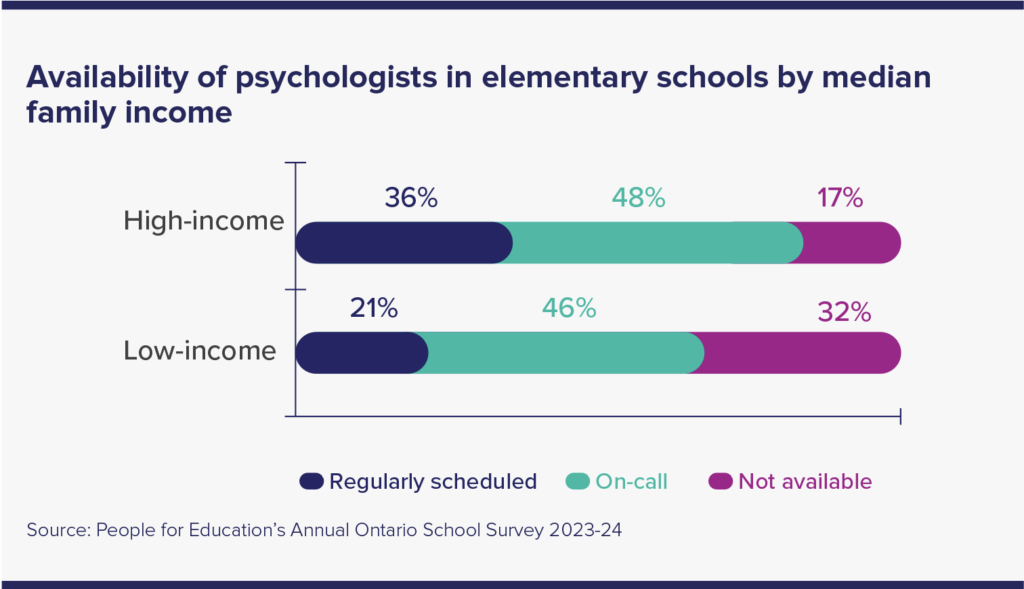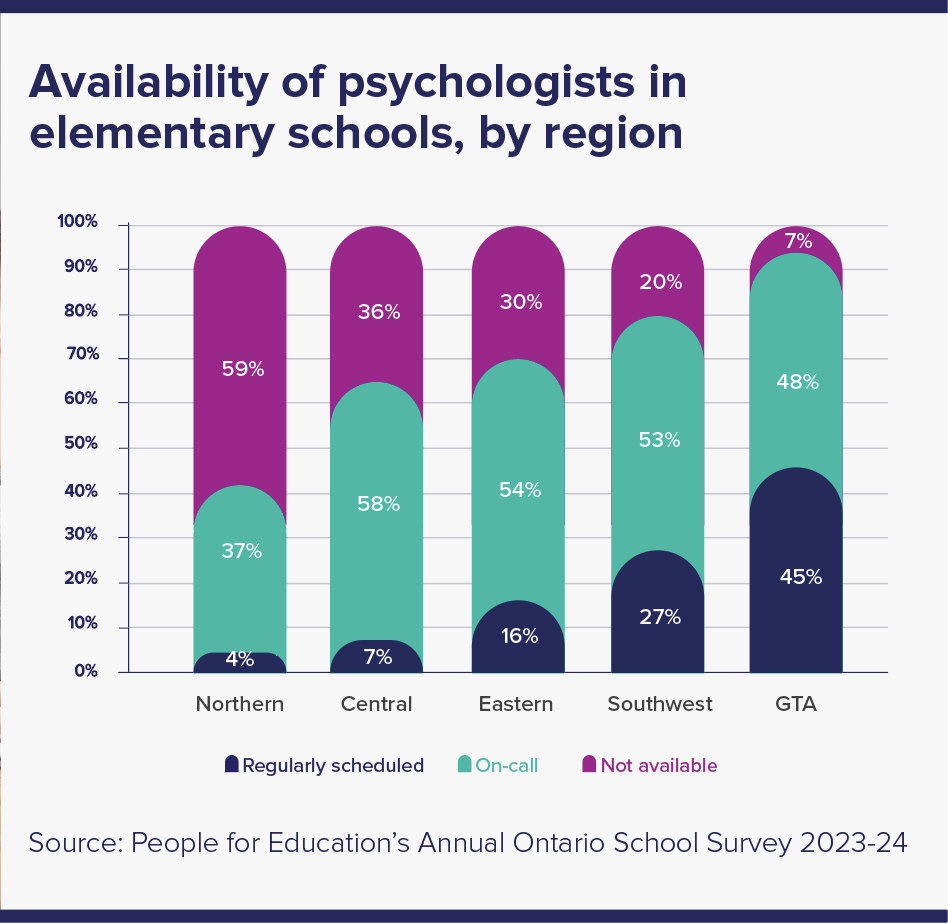Access to special education in Ontario schools: The gaps and challenges
New results from People for Education’s 2023-24 Annual Ontario School Survey show that geography, neighbourhood income, and staff shortages all have an impact on students’ access to special education. The data represent responses from 1,030 of Ontario’s publicly funded schools, representing all regions of the province.
Nearly all Ontario schools have students receiving special education support
In Ontario, nearly every school has at least some students receiving special education assistance, and the proportion of students receiving support has remained relatively steady over the last decade at 16% of elementary students per school, and 28% of secondary students. The types of support students are receiving can range from a little extra daily help in the classroom to intensive support provided by as many as two adults.
Among the findings from the 2023-24 Annual Ontario School Survey:
- 94% of elementary schools and 95% of secondary schools have a special education teacher, either full or part-time – a decline since 2019/20, when100% of elementary and 98% of secondary schools reported having special education teachers.
- On average, the ratio of special education students to special education teachers is 39 to 1 in elementary schools, and 85 to 1 in secondary schools, numbers that have remained fairly stable over the last five years.
- 84% of elementary and 79% of secondary schools have at least one full-time educational assistant. For elementary schools, this represents a steady since 2019/20 when 89% of elementary schools had at least one full-time educational assistant.
- The proportion of principals reporting that they have had to recommend a special education student not attend school has increased steadily since 2013-14, and principals in schools that report daily shortages of educational assistants are much more likely to answer yes to this question.
- Elementary schools in low-income neighbourhoods are much less likely than schools in high-income neighbourhoods (67% vs 84%) to report they have access to psychologists either regularly scheduled or on-call.
Staff shortages having an impact on special education students
Lack of support staff [means] staff who are at school are under extra stress. They are spread too thin.
Elementary school principal, Southwestern Ontario
 In their responses to the survey, many principals commented that daily staff shortages mean that special education teachers must often step in to replace classroom teachers and educational assistants, making them unavailable for special education students. In addition, nearly half of elementary and secondary schools report experiencing shortages of educational assistants every day.
In their responses to the survey, many principals commented that daily staff shortages mean that special education teachers must often step in to replace classroom teachers and educational assistants, making them unavailable for special education students. In addition, nearly half of elementary and secondary schools report experiencing shortages of educational assistants every day.
There are times when the lack of staff results in principals asking parents to keep their students with special needs at home for all or part of the day. The proportion of elementary principals reporting they have recommended a special education student stay home from school increased from 48% in 2013-14 to 63% in 2023-24. In secondary schools, the proportion increased from 40% to 58% over the same period.
There are not enough SERTS (special education resource teachers) or EA’s (educational assistants) in the system. And if they are sick, neither position is ever filled by a qualified staff.
Elementary school principal, Central Ontario
Principals who reported their schools had daily educational assistant shortages were much more likely to report that they have had to recommend students stay home. They were most likely to name safety issues and a lack of necessary support as the reasons that they are forced to make this request.
Access to psychologists affected by neighbourhood income and by geography
The waiting lists for programs and community supports is too long, so students are not receiving services in a timely manner. There are too few Board Psychologists and the few that we do have are being asked to attend far too many meetings, rather than working to clear the backlog of students that need to be assessed.
Elementary school principal, Central Ontario
Most elementary and secondary schools have students waiting to be assessed to determine whether they have specific ministry-recognized special education exceptionalities that would give them a right to special education support. For the most part, students on waiting lists receive special education support despite lacking any official designation.
Assessments are, for the most part, conducted by school psychologists, but in 2023-24, only 26% of elementary schools reported they had regularly scheduled access to psychologists, an all-time low since we have been reporting on this number. The percentage of elementary schools reporting they have no access to psychologists has increased steadily from 13% in 2016-17 to 24% in 2023-24. In secondary schools, 29% reported having no access to a psychologist, up from 16% in 2016-17.
There are significant regional differences in schools’ access to these professionals. Schools in the GTA are much more likely to have access to psychologists either regularly scheduled or on call, whereas schools in Northern Ontario are more likely to report having no access.
In addition to regional differences, elementary schools in neighbourhoods with low median family incomes are less likely to have access to regularly scheduled or on-call psychologists, despite the fact that these schools have higher than average proportions of students receiving special education support.
However, elementary schools in low-income neighborhoods are more likely to provide Individual Education Plans for students waiting for assessment than schools in high-income neighborhoods (90% vs. 74%). Low-income elementary schools are also more likely to provide special education supports to students who have not yet been identified (94% vs 84%).
Recommendation
Principals have consistently pointed to challenges in providing effective special education supports for their students. For this reason, People for Education continues to recommend that the province convene an Education Task Force – including representatives from teacher, principal, and education support staff associations, school board administrators, faculties of education, special education organizations, provincial policymakers, and students – to provide input on government policy before it is implemented, and to help design new policy and funding models to address a range of issues including staff shortages, and effective and equitable design for special education supports and programs.
READ THE FULL REPORT
